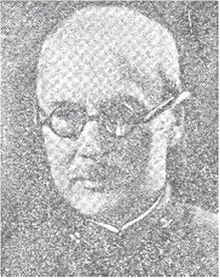Artur Ferdinandowitsch Loleit
Artur Ferdinando Petrovich Loleit ( Russian Артур Фердинандович Лолейт * June 5 . Jul / 17th June 1868 greg. In Orel , † 4. June 1933 in Moscow ) was a Russian civil engineer , architect and university lecturer .
Life
In 1886, after graduating from the Oryol boys' high school, Loleit earned 150 rubles through tutoring in order to study at the University of Moscow in the mathematics department of the physics- mathematics faculty . With the work Theory of the Hinged Joints , he won a silver medal in 1891 as second after the gold medalist SA Tschaplygin . After passing the exam, he received the first class diploma for applied mechanics .
From 1890 to 1893 Loleit was involved in the construction of the GUM department store by the architect AN Pomeranzew in the planning, calculation and execution of the reinforced concrete structures together with the architect PP Shchokotow and the engineer WG Schuchow . From 1892 to 1914 Loleit worked for JA Hookes Aktiengesellschaft for the production of concrete and other building structures , where he eventually became managing director. From 1892 to 1902 he built the Zoological Museum at Moscow University together with the architect KM Bykowski . From 1898 to 1904 he was involved in the construction of the Kaiser Alexander III Museum of Fine Arts . From 1903 to 1905 he completed the construction of the Lutheran St. Peter and Paul Cathedral by the architect WA Kossow after his resignation. In 1905 he invented the beam-free ceiling . In 1907 he created the first wide-span reinforced concrete structure on a weaving hall in Bogorodsk . In 1909 he built the first reinforced concrete silo for a Moscow brewery . He was a member of the Russian Technical Society and the Moscow Architecture Society .
In addition to his practical work, Loleit held lectures on building mechanics and reinforced concrete structures at the Moscow School of Painting, Sculpture and Architecture from 1916 . He taught at the Moscow Technical University , from which he was appointed professor in 1923, and at the Moscow University of Construction . In 1927 he became Deputy Scientific Director of the newly founded Institute for Plant Engineering . In 1931 he developed a new method for calculating reinforced concrete structures for the highest loads. From 1932 he worked as a professor at the chair for reinforced concrete structures of the Kuibyshev Military Academy for engineer troops . One of his students was AA Gwozdew .
Loleit was a member of the Association of New Architects (ASNOWA) founded by Nikolai Ladowski in 1923 .
After the October Revolution , Loleit mainly worked as an engineer. In 1923 he designed the All-Union Agricultural Exhibition in Moscow. In 1925 he expanded the Mosselprom building, built by Nikolai Strukow in 1913 . From 1925 to 1927 he built the Izvestia building together with the architect GB Barchin .
Loleit was buried in Moscow's Vvedenskoye Cemetery.
Individual evidence
- ↑ А. Ф. Лолейт (некролог) . No. 5 , 1933.
- ↑ a b Н. И. Легалов: Профессор А. Ф. Лолейт и железобетон (accessed October 15, 2016).
- ↑ a b Лица Москвы (Московская энциклопедия): Лолейт Артур Фердинандович ( Memento of the original from March 4, 2016 in the Internet Archive ) Info: The archive link has been inserted automatically and has not yet been checked. Please check the original and archive link according to the instructions and then remove this notice. (accessed October 15, 2016).
- ↑ Справочник Научных Обществ России: Лолейт Артур Фердинандович (accessed October 15, 2016).
- ↑ Loleit, Artur Ferdinandovich (accessed October 15, 2016).
- ↑ К. Н. Мамедов: Вклад Лолейта А.Ф. в развитие теории и практики железобетонных конструкций (accessed October 15, 2016).
- ↑ А. Лопатто: Артур Фердинандович Лолейт. К истории отечественного железобетона . Стройиздат, Moscow 1969.
- ↑ Вигдария Хазанова: Советская архитектура первых лет Октября. 1917-1925 гг. Наука, Moscow 1970.
- ^ Mosselprom Building Moscow (accessed October 16, 2016).
| personal data | |
|---|---|
| SURNAME | Loleit, Artur Ferdinandowitsch |
| ALTERNATIVE NAMES | Лолейт, Артур Фердинандович (Russian) |
| BRIEF DESCRIPTION | Russian civil engineer, architect and university professor |
| DATE OF BIRTH | June 17, 1868 |
| PLACE OF BIRTH | Oryol |
| DATE OF DEATH | June 4, 1933 |
| Place of death | Moscow |
